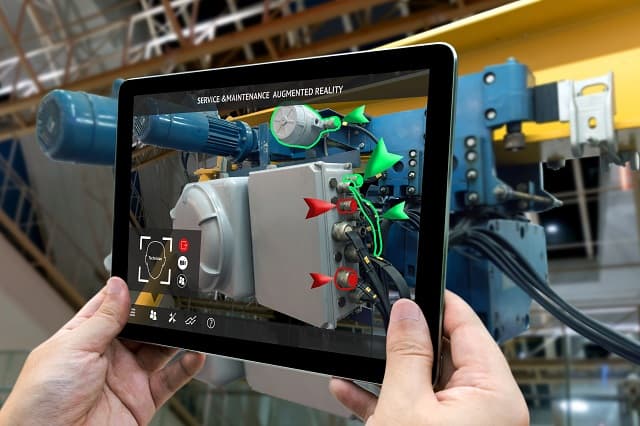Applications of Augmented Reality Technologies
Unlike virtual reality, which creates a simulated environment, augmented reality superimposes computer-generated images in the real world. This helps provide enhanced information about the user’s surrounding environment and creates a sense of cohesion between technology and the real world. As the technology continues to advance, its applications become more varied.
Although less talked about than VR, augmented reality technologies can be used in several ways in the real world. AR has been used to provide turn-by-turn navigation, display business information, OHS, provide students with interactive 3D simulations of historical events, and create immersive gaming experiences.
In this article, we’ll dive into some of the most successful augmented reality applications and explore how this new technology can help improve businesses and institutions around the world. If you ever have the chance to experience these applications, we recommend taking the opportunity and hope you can marvel at the immersive experience.
Optivly and AR
Optivly have embraced AR in a number of ways. As an example, we developed an Augmented Reality app for AMPC which is helping to train butchers and meat workers on how to sharpen their knives correctly. Basically, we built a golf swing analyser for the meat industry! The app is called AngleMe and is available on the app store. We are also leaning heavily into technology like RealWear. Technically, the folks at RealWear term their tech as Mixed Reality as distinct to pure AR owing to their solutions capability to display a full android tablet in front of your dominant eye. See more here.
How Augmented Reality Works
Augmented reality is a technology that allows digital content to be overlaid on top of the physical world. This can be done in real-time and with great accuracy, making it possible to interact with virtual objects as if they were really there.
Once the position and orientation of the device have been determined, the next step is to render the digital content so that it appears correctly in relation to the real world around it. This can be done using specialized software or by using dedicated hardware such as graphics processing units (GPUs).
Since developers can create just about any content, AR technologies are highly adaptable and can be used in a wide range of applications. Some of the most common applications to date include education, military tech, healthcare, construction, and entertainment. In the following sections, we’ll explore each of these fields in more detail and explain how they’ve put AR to good use.
Applications of AR in Education
Augmented reality has the potential to transform education by providing students with a completely immersive learning experience. To date, higher learning institutes and secondary schools around the world have used AR in the following ways:
| Providing Real-Time Feedback – Augmented reality can provide students with real-time feedback on their performance. For example, newly developed apps overlay the correct answer on top of a student’s work if they make a mistake. This allows students to immediately see where they went wrong and how to fix it. |
| Enabling Hands-On Learning – AR has also been used to enable hands-on learning. For example, an anatomy app allows students to see inside the human body and learn about its organs and systems. This technology helps provide a more interactive and engaging way for students to learn about the body. |
| Making Abstract Concepts Concrete – Abstract concepts can be difficult for students to grasp. However, augmented reality can make these concepts more concrete and easier to understand. For example, astronomy apps like SkySafari 7 allow students to see planets and stars in 3D, helping them grasp these concepts more easily. |
These applications have made it easier for teachers to share information and give students the ability to grasp complicated topics without relying on video or text content.
Applications of AR in Healthcare
Augmented reality technologies have been used in the medical field in much of the same way as they have in education. For example, AR has been used for the following applications:
| Medical training – AR tech has been used to create realistic simulations of medical procedures. This has helped trainees learn and practice new skills without putting patients at risk. |
| Patient education – AR can be used to provide patients with information about their condition, treatment options, and what to expect during procedures. This can help them make informed decisions about their care. |
| Remote consultation – AR can be used to connect experts with patients in remote locations. This can improve access to care for patients in underserved areas. |
Although augmented realities may not be real, they can help train and support doctors as they save lives around the world.

Applications of AR in Construction
AR can be used for tasks such as project planning, architectural visualization, and training in the construction industry. Project planners can use AR to visualize how a construction project will progress over time. This can help with coordination and scheduling by allowing planners to see potential conflicts and bottlenecks before they happen.
Architectural visualization can also be used to show clients how a proposed building will look in its finished state. This can help gain project approval or make changes early on in the design process.
Training is another area where AR can be useful in construction. New employees can be given an immersive experience that teaches them about safety procedures or the proper way to operate the equipment. This way, they can prevent accidents and maintain workplace safety.
Applications of AR in the Military
One of the most obvious applications for AR technology in the military is in the field of training and simulation. By superimposing computer-generated images onto a real-world environment, soldiers can be given a real sense of what they might expect to see on a battlefield without putting themselves in harm’s way.
In addition to training, soldiers can also use AR in active combat situations. For example, soldiers could use AR headsets to see through smoke or dust, identify enemy targets, or even call-in airstrikes with greater accuracy. The U.S. Army has already used this type of training, and it is expected that other branches of the military will follow suit.
Applications of AR in Entertainment
There are many potential applications of AR in the entertainment industry. For example, AR could be used to create interactive experiences at live events such as concerts or sporting matches. We’ve already seen this with holographic performances by Michael Jackson and Tupac.
Additionally, AR could be used to enhance video games and other forms of digital entertainment. By creating a real-world game environment, gamers would be able to interact with their favorite characters as if they were there in front of them. When it comes to entertainment, the possibilities for AR applications truly are limitless.
Conclusion
Although AR is still relatively young, there is a growing trend of integrating these technologies into various aspects of our lives—from education and entertainment to retail and healthcare. This technology has the potential to revolutionize how we interact with the world around us and will soon become as ubiquitous as a watch or a cell/mobile phone.
